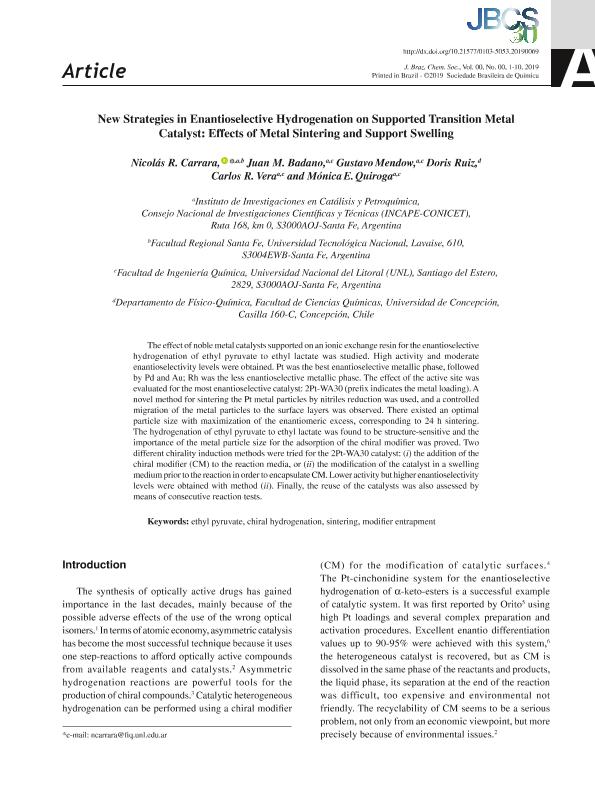Artículo
New Strategies in Enantioselective Hydrogenation on Supported Transition Metal Catalyst: Effects of Metal Sintering and Support Swelling
Carrara, Nicolás Ricardo ; Badano, Juan Manuel
; Badano, Juan Manuel ; Mendow, Gustavo
; Mendow, Gustavo ; Ruiz, Doris; Vera, Carlos Roman
; Ruiz, Doris; Vera, Carlos Roman ; Quiroga, Monica Esther
; Quiroga, Monica Esther
 ; Badano, Juan Manuel
; Badano, Juan Manuel ; Mendow, Gustavo
; Mendow, Gustavo ; Ruiz, Doris; Vera, Carlos Roman
; Ruiz, Doris; Vera, Carlos Roman ; Quiroga, Monica Esther
; Quiroga, Monica Esther
Fecha de publicación:
04/2019
Editorial:
Sociedade Brasileira de Química
Revista:
Journal of the Brazilian Chemical Society
ISSN:
0103-5053
e-ISSN:
1678-4790
Idioma:
Inglés
Tipo de recurso:
Artículo publicado
Clasificación temática:
Resumen
The effect of noble metal catalysts supported on an ionic exchange resin for the enantioselective hydrogenation of ethyl pyruvate to ethyl lactate was studied. High activity and moderate enantioselectivity levels were obtained. Pt was the best enantioselective metallic phase, followed by Pd and Au; Rh was the less enantioselective metallic phase. The effect of the active site was evaluated for the most enantioselective catalyst: 2Pt-WA30. A novel method for sintering the Pt metal particles by nitriles reduction was used, and a controlled migration of the metal particles to the surface layers was observed. There existed an optimal particle size that maximized the enantiomeric excess, corresponding to 24 h sintering. The hydrogenation of ethyl pyruvate to ethyl lactate was found to be structure-sensitive and the importance of the metal particle size for the adsorption of the chiral modifier was proved.Besides, two different chirality induction methods were tried for the 2Pt-WA30 catalyst: i) the addition of the Chiral Modifier to the reaction media, or ii) the modification of the catalyst in a swelling medium prior to the reaction in order to encapsulate the Chiral Modifier. Lower activity but higher enantioselectivity levels were obtained with method (ii).Finally, the reuse of the catalysts was also assessed by means of consecutive reaction tests.
Palabras clave:
ETHYL PYRUVATE
,
CHIRAL HYDROGENATION
,
SINTERING
,
MODIFIER ENTRAPMENT
Archivos asociados
Licencia
Identificadores
Colecciones
Articulos(INCAPE)
Articulos de INST.DE INVEST.EN CATALISIS Y PETROQUIMICA "ING. JOSE MIGUEL PARERA"
Articulos de INST.DE INVEST.EN CATALISIS Y PETROQUIMICA "ING. JOSE MIGUEL PARERA"
Citación
Carrara, Nicolás Ricardo; Badano, Juan Manuel; Mendow, Gustavo; Ruiz, Doris; Vera, Carlos Roman; et al.; New Strategies in Enantioselective Hydrogenation on Supported Transition Metal Catalyst: Effects of Metal Sintering and Support Swelling; Sociedade Brasileira de Química; Journal of the Brazilian Chemical Society; 30; 8; 4-2019; 1678-1687
Compartir
Altmétricas



